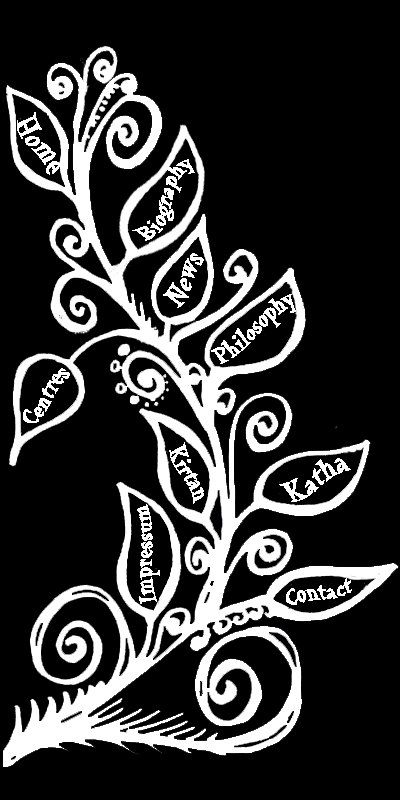 |
|
Philosophy and teachings
 The
spiritual master of Balak Yogeshwar Maharaj, Sri Paramanand
Avadhutji Maharaj, is coming in the Ramanandi-sampradaya
[disciplic succession of Ramanandacharya], which is an off-shoot
of the Sri-sampradaya, one of the four authentic
Vaishnava-sampradayas within “Hinduism”. What looks
like a red exclamation mark on Maharaj's forehead is in fact the
tilak [sacred marking] in the shape of a bindi
[dot] and a vertical line towards the parting of the hair of the
aforementioned sampradaya. The
spiritual master of Balak Yogeshwar Maharaj, Sri Paramanand
Avadhutji Maharaj, is coming in the Ramanandi-sampradaya
[disciplic succession of Ramanandacharya], which is an off-shoot
of the Sri-sampradaya, one of the four authentic
Vaishnava-sampradayas within “Hinduism”. What looks
like a red exclamation mark on Maharaj's forehead is in fact the
tilak [sacred marking] in the shape of a bindi
[dot] and a vertical line towards the parting of the hair of the
aforementioned sampradaya.
According to the Ramanandi-sampradaya, everyone is
eligible to practice bhakti [devotion to God], and
there are no limitations when it comes to caste, gender, age,
ethnicity, etc. The Ramanandi’s primarily worship Lord
Ramachandra and other forms of the Lord related to the Vishnu-tattva
such as Narayana and Lord
 Sri
Krishna. Since the Radha-Krishna Deities had come into Balak
Yogeshwar Mahraja’s life [see
biography], he became
very attached to Them and is calling Them his “Thakurji” [i.e.
Lord of his life]. In a nutshell, it can be stated that Maharaj
is a Radha-Krishna bhakta [devotee], although he
respects every form of God as well as the demigods such as Lord
Brahma, Lord Ganesha and Durga Devi who are all considered
servants of the Supreme. Sri
Krishna. Since the Radha-Krishna Deities had come into Balak
Yogeshwar Mahraja’s life [see
biography], he became
very attached to Them and is calling Them his “Thakurji” [i.e.
Lord of his life]. In a nutshell, it can be stated that Maharaj
is a Radha-Krishna bhakta [devotee], although he
respects every form of God as well as the demigods such as Lord
Brahma, Lord Ganesha and Durga Devi who are all considered
servants of the Supreme.
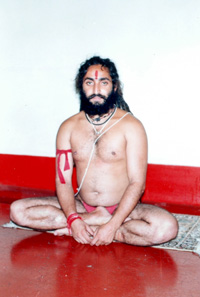 Lord
Shiva, also known as “Mahadeva”, holds a unique key position in
the pantheon of “Hinduism”. Maharaj makes the point that if one
sincerely worships Lord Shiva, He will bring one to the position
of wanting to serve Krishna or Vishnu. Therefore, it is of no
surprise that Maharaj mainly initiates his disciples into a
Krishna-mantra (which is also known as guru-mantra
since it’s given by the guru to the disciple and
it is supposed to be kept hidden). Balak Yogeshwar Maharaj is
advising his disciples to always keep remembering God anywhere
and everywhere and to chant the given mantra throughout
the day. There are no hard and fast rules for remembering the
guru-mantra. Lord
Shiva, also known as “Mahadeva”, holds a unique key position in
the pantheon of “Hinduism”. Maharaj makes the point that if one
sincerely worships Lord Shiva, He will bring one to the position
of wanting to serve Krishna or Vishnu. Therefore, it is of no
surprise that Maharaj mainly initiates his disciples into a
Krishna-mantra (which is also known as guru-mantra
since it’s given by the guru to the disciple and
it is supposed to be kept hidden). Balak Yogeshwar Maharaj is
advising his disciples to always keep remembering God anywhere
and everywhere and to chant the given mantra throughout
the day. There are no hard and fast rules for remembering the
guru-mantra.
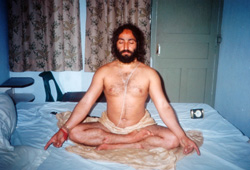 However,
Maharaj has instructed his disciples to sit twice a day – in the
morning and in the evening – in padma-asana
[crossed-legged sitting position] on an asana [mat or
cushion] and breathe regularly through the nostrils while
mentally meditating on the guru-mantra. The mantra
is to be attentively remembered in a three-fold breathing
process; once by breathing in, once by holding one’s breath and
energy at one’s forehead, and once by finally releasing one’s
breath. This process is to be repeated twenty-one times – once
in the morning and once in the evening. However,
Maharaj has instructed his disciples to sit twice a day – in the
morning and in the evening – in padma-asana
[crossed-legged sitting position] on an asana [mat or
cushion] and breathe regularly through the nostrils while
mentally meditating on the guru-mantra. The mantra
is to be attentively remembered in a three-fold breathing
process; once by breathing in, once by holding one’s breath and
energy at one’s forehead, and once by finally releasing one’s
breath. This process is to be repeated twenty-one times – once
in the morning and once in the evening.
 In
general, Maharaj is stressing two main practises in his
teachings: Simran [the soft chanting of mantras
on a rosary, i.e. japa-mala] and seva [service
and kindness] to mankind and all living beings. He repeatedly
states that one should be very careful not to exploit anyone.
Considering this focus, it goes without saying that whoever
approaches Maharaj for mantra-diksa [initiation into
the mantra] is expected to follow a pure vegetarian
life style free from any kind of intoxication and addictions.
One should keep a positive attitude, keep doing positive
activities, have faith in God and continuously watch and purify
one’s thoughts. In
general, Maharaj is stressing two main practises in his
teachings: Simran [the soft chanting of mantras
on a rosary, i.e. japa-mala] and seva [service
and kindness] to mankind and all living beings. He repeatedly
states that one should be very careful not to exploit anyone.
Considering this focus, it goes without saying that whoever
approaches Maharaj for mantra-diksa [initiation into
the mantra] is expected to follow a pure vegetarian
life style free from any kind of intoxication and addictions.
One should keep a positive attitude, keep doing positive
activities, have faith in God and continuously watch and purify
one’s thoughts.
 The
followers of Maharaj can be recognized by a red woolen rosary
with 27 knots which they are wearing around their wrist. Wool is
one of the few materials which cannot be contaminated under any
circumstance, and these rosaries have been hand-tied by a couple
of his female disciples. When this mala [rosary] is
chanted upon four times, it equals to 108 mantras which is
generally the amount of knots or beads of a standard “Hindu”
rosary (4 x 27 = 108). His followers are wearing it at all
times. Very few are chanting on it though. It is more like a
blessed paraphernalia which reminds them of their spiritual
master since Maharaj is personally distributing them during
larger gatherings. The
followers of Maharaj can be recognized by a red woolen rosary
with 27 knots which they are wearing around their wrist. Wool is
one of the few materials which cannot be contaminated under any
circumstance, and these rosaries have been hand-tied by a couple
of his female disciples. When this mala [rosary] is
chanted upon four times, it equals to 108 mantras which is
generally the amount of knots or beads of a standard “Hindu”
rosary (4 x 27 = 108). His followers are wearing it at all
times. Very few are chanting on it though. It is more like a
blessed paraphernalia which reminds them of their spiritual
master since Maharaj is personally distributing them during
larger gatherings.
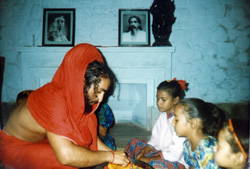 Another
interesting feature in Maharaj’s spiritual practice is the
worship of the kanya-kumaris [small girls] which he
occasionally does during larger functions. He’s washing the feet
of small girls, feeding them, giving them donations, and bowing
down in front of them. Sri Vaishno Devi, a great female saint
who got bugged by a lusty man during her meditational practices
in the mountains of Katra (which is situated in Jammu and
Kashmir), appeared to that very man as Durga Devi and destroyed
him with her many gruesome weapons. Therefore, the worship of
Durga Devi (of which the Another
interesting feature in Maharaj’s spiritual practice is the
worship of the kanya-kumaris [small girls] which he
occasionally does during larger functions. He’s washing the feet
of small girls, feeding them, giving them donations, and bowing
down in front of them. Sri Vaishno Devi, a great female saint
who got bugged by a lusty man during her meditational practices
in the mountains of Katra (which is situated in Jammu and
Kashmir), appeared to that very man as Durga Devi and destroyed
him with her many gruesome weapons. Therefore, the worship of
Durga Devi (of which the
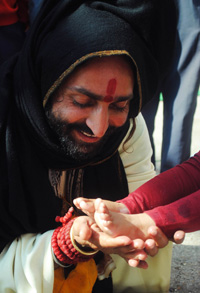 small
girls are being considered an expansion) is deeply imbibed in
the culture of Jammu and Kashmir. It is one of the states in
India where the ladies are being properly respected. No place in
this world can flourish without properly respecting and taking
care of its female inhabitants. The Goddess of fortune - Laksmi
- of whom Durga Devi is but an expansion, will not inhabit a
place where the females are disrespected. Therefore, wherever
ladies get disrespected, that place will be disturbed by poverty
sooner or later. small
girls are being considered an expansion) is deeply imbibed in
the culture of Jammu and Kashmir. It is one of the states in
India where the ladies are being properly respected. No place in
this world can flourish without properly respecting and taking
care of its female inhabitants. The Goddess of fortune - Laksmi
- of whom Durga Devi is but an expansion, will not inhabit a
place where the females are disrespected. Therefore, wherever
ladies get disrespected, that place will be disturbed by poverty
sooner or later.
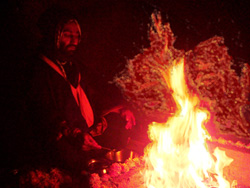 Balak
Yogeshwar Maharaj has started this practise of worshiping young
girls during his days in Badrinath where he observed the
Navaratri-vratta [spiritual vow] strictly. He would
completely fast for nine entire days and would perform
havana [sacred fire sacrifices] daily. He would not touch
anyone, nor was anyone allowed to touch him during these days.
On the tenth day of Navaratri, he would worship some small girls
in the aforementioned way. He’d be calling Mata Vaishno Devi
into the small girls and would perform the kanya-kumari-puja
in this way. In return, he’d get support from Devi to accomplish
major tasks in this world such as his havana-gatherings
and other big projects. Maya [the illusionary potency of the
Lord] would then not create any obstacles and disturbances on
his spiritual path. Balak
Yogeshwar Maharaj has started this practise of worshiping young
girls during his days in Badrinath where he observed the
Navaratri-vratta [spiritual vow] strictly. He would
completely fast for nine entire days and would perform
havana [sacred fire sacrifices] daily. He would not touch
anyone, nor was anyone allowed to touch him during these days.
On the tenth day of Navaratri, he would worship some small girls
in the aforementioned way. He’d be calling Mata Vaishno Devi
into the small girls and would perform the kanya-kumari-puja
in this way. In return, he’d get support from Devi to accomplish
major tasks in this world such as his havana-gatherings
and other big projects. Maya [the illusionary potency of the
Lord] would then not create any obstacles and disturbances on
his spiritual path.
 Last,
but not least, Maharaj is often repeating the words of the great
saint Tulsidas, who compiled the famous Ramcharitmanas [a
summary of the Ramayana in verse-form], and who has appeared in
the Ramanandi-sampradya. Saint Tulsidas has stated:
“Kalyug kewal naam adhara, sumer sumer nar uttara hin para”.
The meaning of this verse is that in this age of Kali, only the
chanting of God’s divine names is sufficient to sail the human
beings through the deep ocean of this material existence. The
holy names of the Lord will bless its chanter with bliss and
peace and grant him liberation from the repeated cycle of birth
and death. Last,
but not least, Maharaj is often repeating the words of the great
saint Tulsidas, who compiled the famous Ramcharitmanas [a
summary of the Ramayana in verse-form], and who has appeared in
the Ramanandi-sampradya. Saint Tulsidas has stated:
“Kalyug kewal naam adhara, sumer sumer nar uttara hin para”.
The meaning of this verse is that in this age of Kali, only the
chanting of God’s divine names is sufficient to sail the human
beings through the deep ocean of this material existence. The
holy names of the Lord will bless its chanter with bliss and
peace and grant him liberation from the repeated cycle of birth
and death.
Maharaj considers the performance of havana an
opportunity to bring a large crowd together in one place and
have them chant God’s names together which is a very powerful
way of spiritual advancement in this age of Kali.
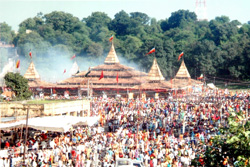
Eventually, no matter how much research one might do on
Maharaj’s life and teachings, there will always be a mystical
and unpredictable moment about Maharaj which makes him so
unfathomable and unique.

HARI OM TAT SAT!
|

